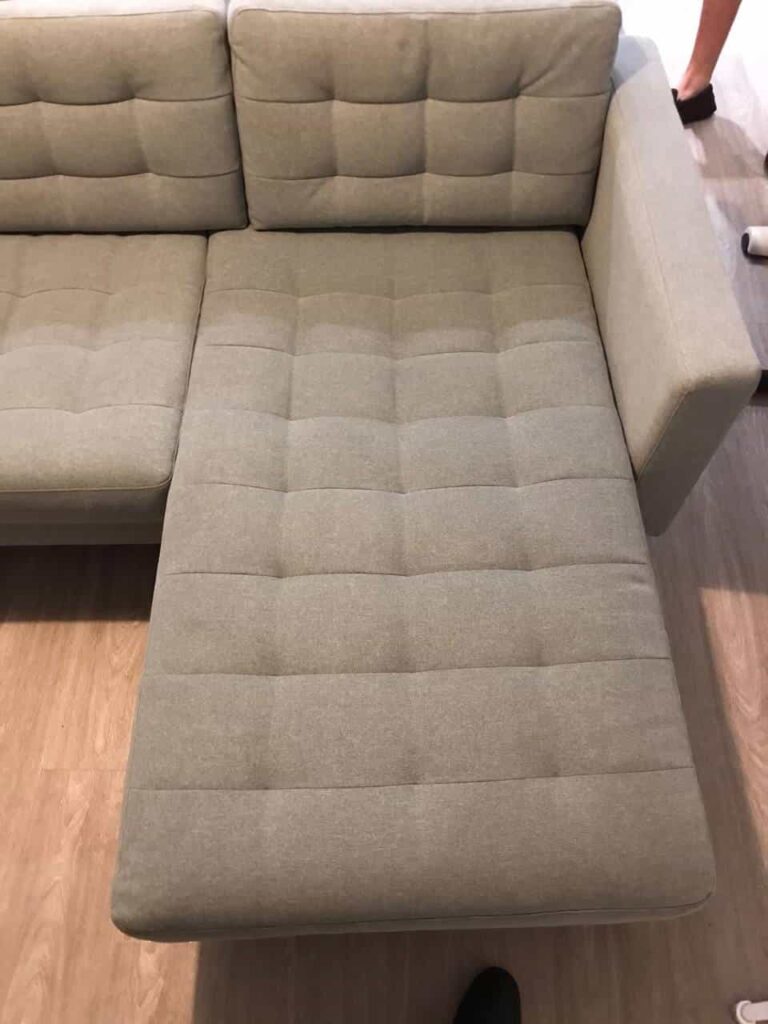If you’ve ever found yourself sneezing or experiencing allergy-like symptoms while relaxing on your sofa, the culprit may be right beneath you. Upholstered furniture, particularly sofas, can harbour dust, allergens, and other irritants that trigger allergic reactions. At K&S Carpet Cleaning Aylesham, we understand the importance of keeping your home environment clean and allergen-free. In this blog post, we’ll explore how dust in upholstery can impact your health and what you can do to reduce allergens in your home.
Why Sofas Accumulate Dust and Allergens
- Dust Settling in Fabric Fibres Sofas, like any upholstered furniture, act as magnets for dust. Dust particles, which consist of tiny fragments of skin cells, dirt, pollen, and even insect droppings, can become trapped in the fibres of your sofa. Over time, these particles accumulate and can be released into the air every time you sit or move on the furniture, leading to sneezing, coughing, or more serious allergic reactions.
- Trapped Pet Hair and Dander If you have pets, your sofa is likely to harbour pet hair and dander—tiny flakes of skin shed by animals. Pet dander is one of the most common allergens and can easily get embedded in the fabric of your sofa. Even if your pets aren’t allowed on the furniture, dander can still spread throughout your home and settle on surfaces like your sofa, contributing to allergic symptoms.
- Dust Mites Thriving in Upholstery Dust mites are microscopic creatures that thrive in warm, humid environments and feed on the dead skin cells found in dust. Upholstered furniture provides the perfect habitat for dust mites, which can multiply rapidly if not addressed. While dust mites themselves aren’t harmful, their waste products can trigger allergic reactions, particularly in those with asthma or dust mite allergies.
- Poor Air Circulation Poor air circulation in your home can cause dust and allergens to settle on your furniture more easily. When air isn’t moving, dust particles can accumulate on surfaces like your sofa, where they become trapped in the fabric and contribute to indoor air pollution. Regular cleaning and improving ventilation can help reduce the build-up of allergens.
How Dust in Upholstery Affects Your Health
- Allergy Symptoms Common allergy symptoms, such as sneezing, runny nose, itchy eyes, and coughing, can all be triggered by the dust and allergens present in your sofa. These symptoms can become particularly noticeable when spending long periods of time sitting on or near your furniture, especially if it hasn’t been cleaned regularly.
- Respiratory Issues For those with asthma or other respiratory conditions, dust in upholstery can exacerbate breathing difficulties. Dust mites, pet dander, and other allergens can irritate the airways, leading to increased asthma attacks or more frequent use of inhalers. Keeping your upholstery clean is essential to maintaining a healthy indoor environment, especially for those with pre-existing respiratory conditions.
- Worsened Indoor Air Quality Dust and allergens trapped in your sofa don’t stay there. Every time you sit down or move on the furniture, these particles can be released into the air, worsening indoor air quality. Poor indoor air quality can lead to a range of health issues, from mild discomfort to more serious conditions like chronic respiratory problems.
How to Reduce Dust and Allergens in Your Sofa
- Regular Vacuuming One of the simplest ways to reduce dust and allergens in your upholstery is to vacuum your sofa regularly. Use an upholstery attachment on your vacuum cleaner to reach deep into the fabric and remove dust, pet hair, and other particles. Regular vacuuming helps to prevent the build-up of dust and keeps your sofa fresh between professional cleanings.
- Professional Upholstery Cleaning While regular vacuuming is important, it’s not enough to fully eliminate allergens that are embedded deep within the fabric of your sofa. Professional upholstery cleaning uses specialised equipment to thoroughly clean your sofa, removing dust mites, pet dander, and other allergens that ordinary cleaning methods can’t reach. At K&S Carpet Cleaning Aylesham, we offer expert upholstery cleaning services that help keep your furniture clean and allergen-free.
- Use Hypoallergenic Covers Consider using hypoallergenic covers for your sofa and other upholstered furniture. These covers are designed to block dust mites and allergens, helping to reduce exposure to irritants. Hypoallergenic covers are easy to remove and wash, making them a practical solution for those with allergies.
- Improve Air Circulation Enhancing the air circulation in your home can reduce the amount of dust and allergens that settle on your sofa. Use fans, open windows, or invest in an air purifier to keep the air moving and improve the overall air quality in your home. Keeping humidity levels low also helps to discourage dust mites from thriving.
- Wash Removable Covers and Cushions If your sofa has removable covers or cushions, make sure to wash them regularly. Follow the care instructions on the fabric to ensure that you’re cleaning them properly without damaging the material. Washing these covers frequently can help reduce allergens and keep your sofa looking fresh.
Conclusion
Your sofa could be contributing to your sneezing and allergy symptoms if it’s harbouring dust, pet dander, and other allergens. Regular vacuuming, professional upholstery cleaning, and improving air circulation are all effective ways to reduce allergens and improve your home’s indoor air quality. At K&S Carpet Cleaning Aylesham, we offer expert upholstery cleaning services that help keep your furniture spotless and your home healthy.
Call us on: 01304 796 897
Click here to find out more about K&S Carpet Cleaning Aylesham
Click here to complete our contact form and see how we can help with your Carpet needs.

